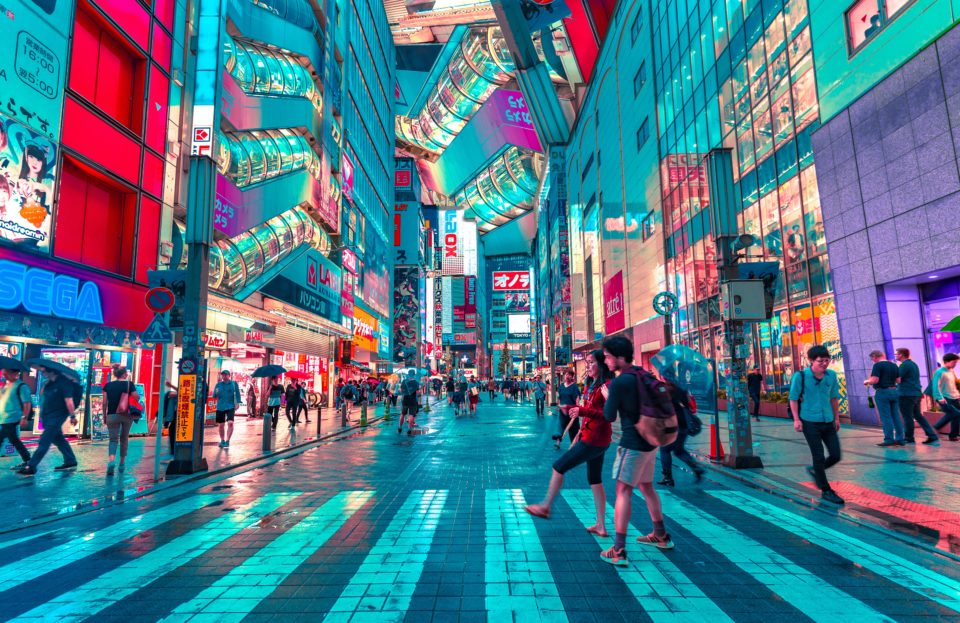How Admix is bringing product placement to the world of gaming


Wherever you are reading this right now, pause and look around you. What do you see? Or more specifically, how many brands do you see? Not just in adverts in your vicinity, but the objects around you. There’s probably quite a few, right? From the smartphone or computer before you to drinks to cars to clothes and a whole lot more.
This is the experience that Admix is bringing to the world of games. Rather than intrusive video ads, pop-ups or banners, it wants to make advertising part of the in-game world in a way that makes sense. It wants ads to fit their virtual environments in an intelligent way that respects those playing the game.
We spoke to Samuel Huber, founder and CEO, about how product placement works in the world of gaming, why context matters more than personalisation and where traditional advertising is going wrong.
Samuel Huber, Founder and CEO, Admix

Can you tell us what Admix does in a nutshell?
Admix is a monetisation platform for games including virtual reality (VR), augmented reality (AR), e-sports. We most target game developers. This also includes gamified environments and virtual places where people hang out whether it’s to play games or to socialise or simply for the purpose of entertainment.
Gaming is becoming truly mainstream. Everyone plays a game one way or another. Developers are looking for new ways to make money from their content. Traditionally, they’ve used different ways to advertise whether it’s videos playing before content or banners at the bottom of the screen or in-game mechanics where you can pay to play. But we find that’s more and more they’re looking for new business models that also respect the users.
We have created a way to advertise within the game without interrupting the gameplay. It’s like product placement through giving the creators of these games the ability to control this experience by effectively tagging areas of their content that they want to sell to advertisers.
If you have a football game you can tag the side of the stadium and replace the banners with real ads, for example, or if it’s a shooter game or a driving game that takes place in the city you can replace billboards with real billboards that will be sold to brands. Brands can become part of the conversation this way.
We are device agnostic. We integrate at the game engine level, which is the software where the game has been designed. From there you can decide to publish the game in VR, or you can decide to publish it as a mobile game. It really doesn’t matter if you see it on a screen or in a headset. We have about 200 game creators at the moment and thousands of buyers that are interested in being integrated within those environments.
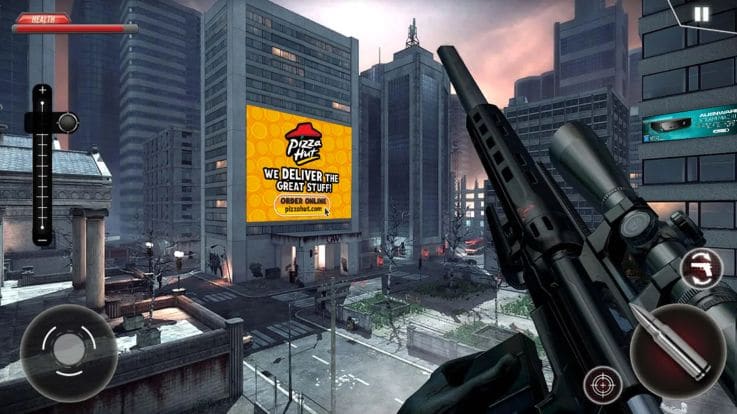
Where did the idea come from?
I initially got a job in engineering was working for Mercedes in the Formula One industry, but I started to work on the side on app projects. A couple of them took off and I saw a future there.
We launched a small agency in London, and we built some of the first hyper casual games, which are games that are really simple to play. The big lesson through that period of time was that monetisation was really the key. We tried 17 different solutions and they were all the same. They were providing short term revenue, but long term they were affecting the user retention because people started to get annoyed about the intrusion of the adverts and the interruption of the experience.
At that time, I started dreaming about new ways to monetise. How could we use the great tool that is advertising, but also respect the user experience and their time and attention? We could see a trend towards more immersive gaming. We’re moving from two-dimensional screens like the PC and the mobile to VR, AR and e-sports where you are much more immersed in the gameplay. I could see that the advertising industry was not moving in that direction at all. The more immersed you are the less traditional intrusive advertising would have a place.
In mid-2017 I set on this product placement idea. It was a really revolutionary idea at the time when brands were not used to being part of games like this. They used to be on another layer. When the game stops, you might have an ad as a transition, but not in the gameplay itself. It required a lot of education and evangelism to really make the brands understand why this is valuable.
Last year was the tipping point. Gaming is really becoming the new form of entertainment. It’s a $160 billion dollar a year industry, which is bigger than the movie and the music industries together. Games have really expanded from hardcore gaming to all kinds of games from Candy Crush all the way to Fortnite. There are 1.5 billion users playing every day. Brands are starting to realise that this is such a massive channel that they need to be part of this conversation and they need the right tools to be able to engage gamers properly.

Which brands or agencies are most onboard with this type of advertising?
Initially, our assumption was that the niche brands of the gaming industry would be the most interested. However, because we work programmatically and plug into the big ad networks – Verizon, Google, Adnexus – all types of brands can come in to buy the audience that we have.
They actually not buying gaming because it’s gaming. They’re buying our audience because gaming is so big that you can reach literally everyone. It’s like someone advertising on Facebook. They don’t do it because it’s Facebook. They do it because everyone is on Facebook and they’re starting to realise that it’s the same with gaming.
We have over a thousand brands buying from us every month from very small amounts to much larger campaigns. If you look at the mix, it’s actually very distributed. We have automotive manufacturers, insurance companies, media brands, FMCG, services and gaming brands.

Have you seen any particularly creative or inspiring uses of ads in games?
For the first time we are providing a tool for the game developers to craft their own advertising experience. Traditionally, as a content creator you don’t really have a choice as to how the advertising experience will look, but with Admix you can actually integrate it in the way you want.
We’ve seen game developers that have applied a texture on top of the ad, for example, so instead of just seeing an ad on a wall it looks like it’s been painted on the bricks. It really looks like an out-of-home experience.
We worked with developers of a football game who decided that not only did they want ads around the stadium, but they went out of their way to build a big Jumbotron screen on top that the player would always see in the corner of their eye where video ads would be playing.
It’s quite a big change, not in the gameplay, but in the graphics to add this thing on top, especially for the purpose of advertising. This is where I really understood the power of giving developers control, because from there they can really make advertising part of the story.
We’re starting to see more and more exciting examples like this such as ads on moving cars where the ad fits the shape of the car, so it looks like it’s painted on top of it. We are experimenting with more and more tools to make the ads more native, including the 3D ads which are 3D products that are launching later this year.
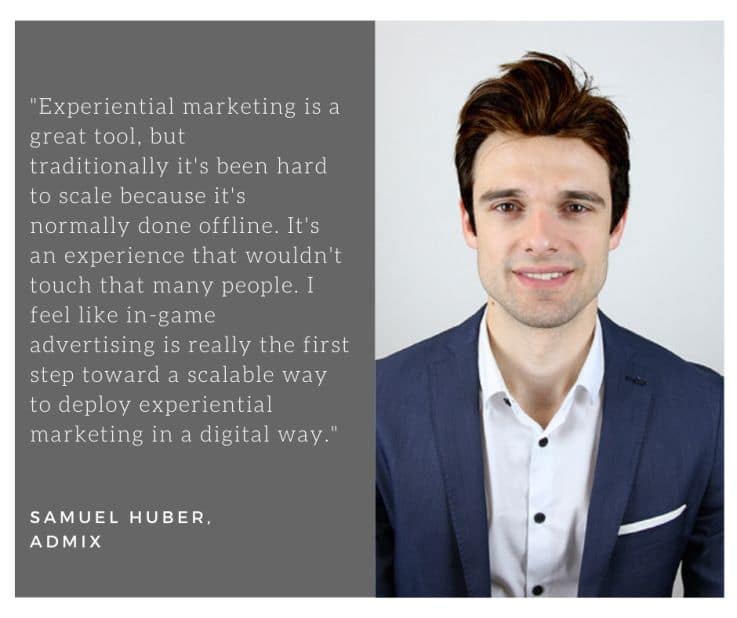
Can people interact with the ads?
We are building capabilities for that at the moment. We have been going step-by-step and focusing on putting 2D assets within 3D games. You can interact with them by looking at them or approaching the ad, but at the moment it’s more about branding.
The developer can decide if they want the ads to be clickable and if you tap it within the game you could be taken to another page to download an app, for example. But that hasn’t really been our focus too much until now.
The next step is to move from an attention model to an interaction model where with 3D ads you will be able to perform different actions. Again, the goal here is that the advertiser or the agency would be able to create their own micro-experience. For example, when someone touches a can of Coke the can opens or when someone grabs it music starts to play.
The brand could literally build this through a little tool that we would provide them and then publish this as an interactive ad unit within our inventory. People in the gameplay could then interact with it in different ways by looking at the can, touching the can, gifting the can to a friend. All these interaction points would drive different price points because it shows different levels of engagement with the brand.
It’s moving to more of an experiential marketing model where we would charge the brand more depending on the engagement that they are driving with their users. We have already done some tests with sneaker brands, for example, where you could take the sneaker and your character could try it on within the game and get the ability to run faster.
This is where the brand really becomes part of the story and gameplay. We’re trying to blur the line as much as possible between real world brands and the gameplay. Our vision is that you can look at the game world and everything around you is branded just like in real life. You look at your phone; it has a brand on it. You look at your bag; it has a brand on it. You look at a bottle in your kitchen; it has a brand on it. The idea is to really integrate product placement as part of the gameplay so that it would never interrupt.
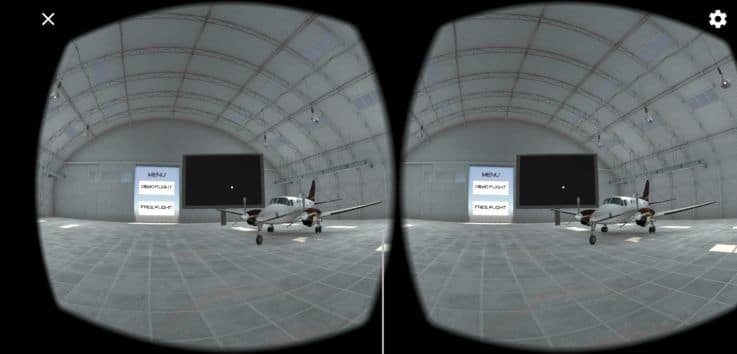
What information is shared about users? Is there any personalisation in the ads?
We are being very cautious with user privacy. We actually don’t really need it much because in these environments context matters even more than personalisation. It’s more about finding ads that are great for that type of environment rather than the actual type of player or person that enters the game.
Within that, we rely on the data that the game publisher wants to give us. Sometimes it might just be a broad location. For example, if we know the country of the user, we can make sure that if we proposed a car ad it’s going to be a car that is available in that country. Sometimes we have a bit more information like age range or gender, and we can try to tailor the ad a bit better based on that.

What’s your view of traditional advertising?
The whole industry is in crisis. I love the concept of advertising. It has really been the backbone of every mainstream media. It’s part of our culture. It’s extremely important.
But I think the internet really killed advertising. Before the internet, I think the average person was seeing around 50 to 100 ads a day. With the internet, it’s close to 5000 as the internet is literally plastered with ads. That has created its downfall.
More and more we are blind to advertising. If there is a banner or video in between an article, we’re just going to scroll past or try to close it. It’s become a reflex almost. This is even more true for younger generations who are completely blind to advertising. Not only do they use ad blockers, but they do not actually interact with the ads when they do see them.
The industry doesn’t know what to do. They are completely lost as to how to reach these young people who are consuming the web in different ways. I think that we are providing one of the solutions in that actually you can engage with users if you try to be a bit smart about where you reach them – in places where they’re willing to engage – but also how you reach them.
Experiential marketing is a great tool, but traditionally it’s been hard to scale because it’s normally done offline. It’s an experience that wouldn’t touch that many people. I feel like in-game advertising is really the first step toward a scalable way to deploy experiential marketing in a digital way.
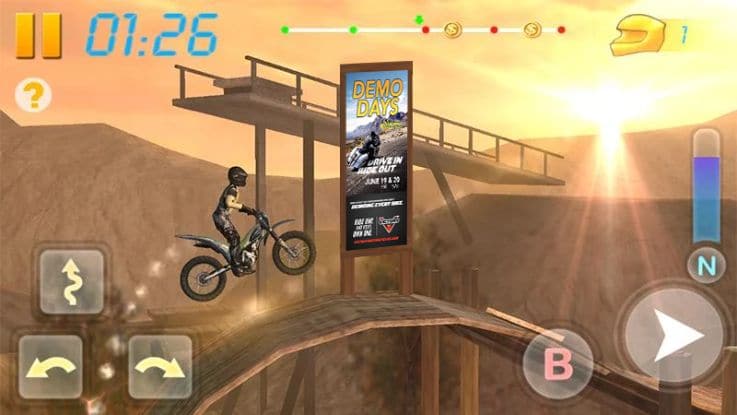
What is your outlook for mixed reality?
I’m very much convinced that spatial computing, which is the global banner that covers VR, AR and XR, is really the next computing platform. We went from having mainframe computers that were as big as a football stadium to putting the computer on the table. Then we put it in our pockets. Next thing you know, we’re going to put it on our bodies. That’s the next revolution. It’s really the ultimate computing platform because we’re not going to rely on these screens as much anymore. We are going to have information sent to our brain through the glasses or the headset whenever we need it.
It’s not going to happen overnight. If you think about the first mobile phones, they were were massive. They were really heavy. Everyone thought ‘why would someone carry something like this?’ Now we have computers in our pockets that are more powerful than the rocket that took people to the moon in 1969. It evolves really, really fast.
I think the VR headsets so far were really the first prototype of what VR could be. We’re starting to see that we’re going to be able to miniaturise that massively. It’s going to be lighter. It’s also going to have a much better form factor, so people would be able to wear it like traditional glasses. I think there was some unreasonable expectation of how fast this computing platform should become mainstream, which is silly because even today there are a lot of countries where smartphone penetration is really just starting.
It’s going to take time. But we’ve already started; we are already wearing the Apple Watch and the AirPods. The technology is getting more and more advanced so that we will be able to eventually get rid of the screens effectively. I feel like within the next decade, just like it took about 10 years for mobile to go from early adopters to really becoming mainstream, it is really going to be about getting those computers smaller in a way that we can actually wear them. By 2030, I think 95% of millennials and younger generation will use spatial computing features at least once a day.
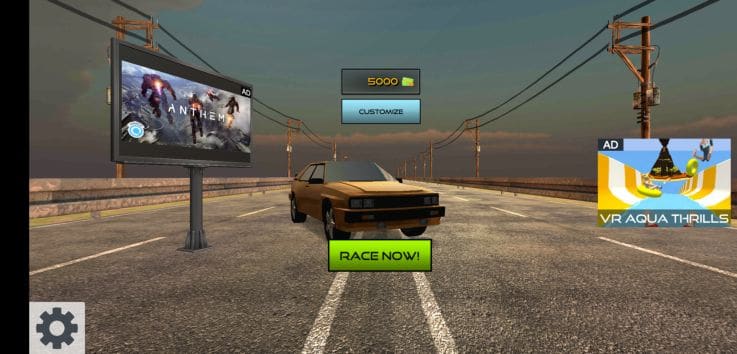
How might this impact retail?
I think the main thing with retail is that they are trying to create a better shopping experience and make the products more tangible, especially when it’s digital retail. I feel like VR, AR, XR are definitely great tools for this. You can really feel like you’re experimenting with the products to make it more tangible and understand what it would feel like to own the product.
It’s quite a simple offering, but it’s a really complicated execution. I haven’t actually seen that many retailers who do this in the right way. A lot of them are trying to emulate what they would do in the real world, like walking through a shopping centre in VR, which is silly. You can buy something in two taps on your mobile. Why would you put on a headset and go through the pain of walking through the aisles of the shopping centre?
It adds tremendous friction. A big challenge for the retailers is trying to leverage these great features without adding extra friction to make it an even better experience than mobile, because only if it improves the current experience will people use it. Otherwise, it would just remain a gimmick and no one would actually use it.
I’ve seen a couple of virtual try-ons, but it still doesn’t look 100% real. There’s still a bit of latency. You can still see it’s a digital product. It’s a great concept. But actually, would you make a decision to buy the product based on this? I don’t think so just yet.
I think it’s pretty clear that when you can blur the boundaries between the digital and the real and really make people try before they buy or experience the product or the service in a digital way you can maximise purchases. We know that tangibility, the ability to feel what it would be to own something, is a big driver in the purchase.
Are there any big learnings from Admix so far?
I think the biggest learning is if you want to start a business focusing on something that is really transformational is key. You need to focus on big concepts that are part of a growing trend, not just a product that you think is cool, but something where you can see that the world is changing in that way. The biggest thing is asking what is currently changing and what can I build as part of that?
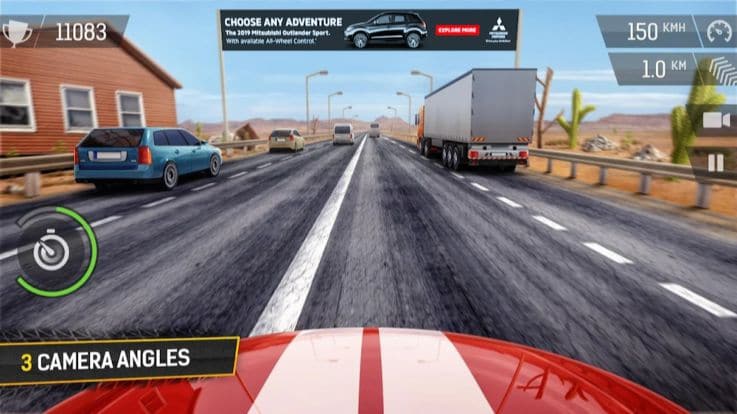
What excites you most about the industry at the moment?
I think what excites me the most is that we are moving more into infrastructure and tools for VR and AR developers, which are really going to enable the whole industry to scale.
When I got started on mobile, we just focused on building mobile apps. We didn’t have to worry about building a monetisation platform as there were literally hundreds to pick from. There were services to acquire users and analytics that you could integrate. We could focus on just building apps and use those building blocks of infrastructure.
Right now, if you’re building VR, you don’t have analytics, you don’t have ways to acquire users easily. You have to build all the foundations. The things that we’re doing, which is monetisation, will be one of the building blocks that future creators can use to make their life easier and just focus on what they do best, which is building content.
In addition to Admix, we’re trying to build a developer community, whether you’re building games or esports or VR. We run a platform called VR Focus, which is focused on VR/AR news and has over 2 million unique visitors a year.
More recently, we’ve launched VR/AR Pioneers, which is a free collection of resources for developers of immersive content who want to grow their businesses. Whether you want to know how to acquire users or how to finish your game, how to publish it, how to make money with it, you can find free resources on it. We have a big Facebook group as well where everyone can help each other, so it’s a really active community.
Images courtesy of Admix


